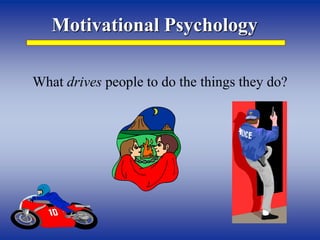
Motivational Psychology: Understanding What Drives Human Behavior
- 1. Motivational Psychology What drives people to do the things they do?
- 2. Basic Concepts Motives – internal states that arouse and direct behavior toward specific objects or goals Needs – states of tension within a person
- 4. Motive Psychology People differ in the type and strength of their motives These differences are measurable These differences cause or are associated with important life outcomes Differences will be stable over time Motives can answer: why do people do what they do. Traits answer the question how people do what they do
- 5. Motive Psychology Henry Murray’s Theory of Needs Needs organize perception, guiding us to ‘see’ what we want (need) to see “A need refers to a potentiality or readiness to respond in a certain way under certain given circumstances”
- 6. Motive Psychology Henry Murray’s Theory of Needs Figure 8-1: 20 fundamental human needs Hierarchy of needs: an individual’s various needs can have different levels of strength The interaction of the levels of needs makes the motive concept dynamic
- 7. Motive Psychology Henry Murray’s Theory of Needs Press: need-relevant aspects of the environment Alpha press – real environment Beta press – perceived environment
- 8. Motive Psychology Henry Murray’s Theory of Needs Apperception: the act of interpreting the environment and perceiving the meaning of what is going on in a situation Thematic Apperception Technique (TAT)
- 10. Sample TAT card
- 11. TAT and Questionnaire Measures of Motives: Do They Measure Different Aspects of Motives? • McClelland argues that responses to TAT and questionnaire measures are not correlated because they measure two different types of motivation • TAT measures implicit motivation— unconscious desires, aspirations, and needs
- 12. TAT and Questionnaire Measures of Motives: Do They Measure Different Aspects of Motives? • Questionnaires measure explicit or self- attributed motivation—reflect a person’s self- awareness of conscious motives • Implicit motives better predict long-term behavioral trends over time
- 13. TAT and Questionnaire Measures of Motives: Do They Measure Different Aspects of Motives? • Explicit motives better predict responses to immediate, specific situations and to choice behaviors and attitudes
- 14. The Big Three Motives Achievement Power Intimacy
- 15. Need for Achievement • People who have a high need for achievement: – Prefer activities that offer some, but not too much, challenge – Enjoy tasks where they are personally responsible for the outcome – Prefer tasks where feedback on their performance is available
- 16. Need for Achievement • Sex differences: Life outcomes and childhood experiences • Promoting achievement motivation: Independence training and setting challenging standards for children
- 17. Need for Power • Readiness or preference for having an impact on people • People with a high need for power are interested in controlling situations and controlling others
- 18. Need for Power • Sex differences: Largest is that men but not women with high need for power perform a variety of impulsive and aggressive behaviors • Profligate impulsive behaviors (drinking, aggression, sexual exploitation) is less likely to occur if a person has responsibility training
- 19. Need for Power • People with a high need for power do not deal well with frustration and conflict— show strong stress responses, including high blood pressure
- 20. Need for Intimacy • Recurrent preference for or readiness for warm, close, communicative interactions with others • People with a high (compared to those with low) need for intimacy: – Spend more time during day thinking about relationships – Report more pleasant emotions when around other people
- 21. Need for Intimacy • People with a high (compared to those with low) need for intimacy: – Smile, laugh, make more eye contact – Start up conversations more frequently and write more letters
- 22. Need for Intimacy • Consistent sex difference: Women, on average, have a higher need for intimacy
- 23. The Humanistic Tradition: The Motive to Self-Actualize The meaning of any person’s life is found in the choices that person makes and the responsibility they take for those choices Emphasizes the human need for growth and realizing one’s full potential
- 24. The Humanistic Tradition: The Motive to Self-Actualize Maslow’s Hierarchy of Needs Needs are hierarchically organized Needs must be satisfied at the lower levels before we proceed to satisfy the higher needs Lower needs are more powerful and pressing
- 26. The Humanistic Tradition: The Motive to Self-Actualize Maslow’s Hierarchy of Needs Research Findings Characteristics of Self-Actualizing Persons
- 27. The Humanistic Tradition: The Motive to Self-Actualize Roger’s Contributions The fully functioning person Positive regard Conditions of worth
- 28. The Humanistic Tradition: The Motive to Self-Actualize Roger’s Contributions Anxiety and Distortion Client-Centered Therapy Genuine Acceptance Unconditional Positive Regard Empathic Understanding
- 29. The Humanistic Tradition: The Motive to Self-Actualize Research on empathy Not heritable Can be effectively taught Empathic ability increases with practice
- 30. Summary Murray: needs differ in strength, and the intensity fluctuates over time and situations TAT: technique of motivation measurement Achievement, Power, Intimacy Self-Actualization